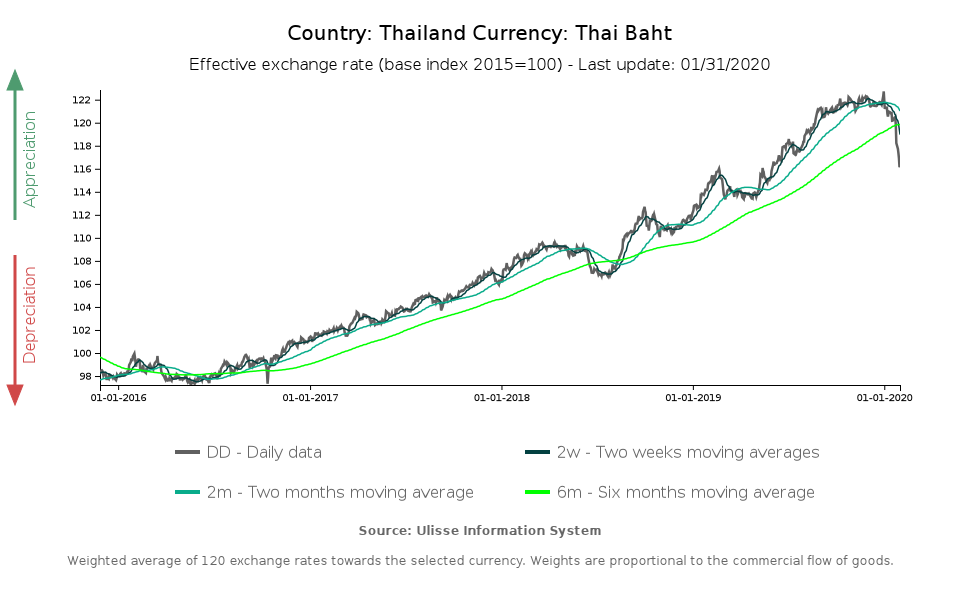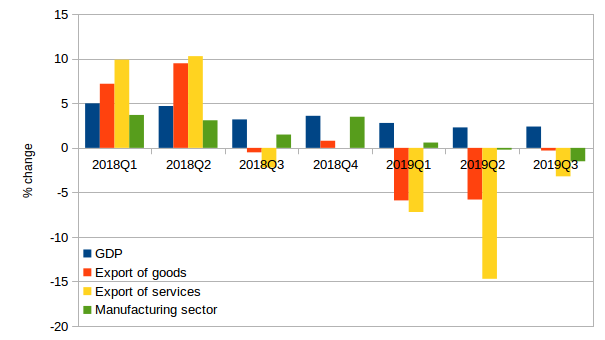Thai Baht: Pulling the Brake
Worries over economic competitiveness and Coronavirus effect impact on the currency.
Published by Alba Di Rosa. .
Exchange rate Asia Central banks Uncertainty Trade balance Exchange rate risk Emerging markets Exchange ratesAmong this week's financial headlines, one of the most relevant involves the great turnabout of the Thai baht. After a continuous appreciation since early 2016 - which led the currency to strengthen by 23% over 4 years in terms of effective exchange rate (EER) - the baht has experienced a significant depreciation since the beginning of January: -5.3% (EER), as can be seen from the graph below.

The factors that help explain this dynamics can be traced back to domestic and international elements.
Thai central bank: stemming the strong baht to safeguard economic competitiveness
As written in previous articles, the appreciation trend shown by the baht is supported by several factors:
- A positive current account balance, in which a buoyant tourism industry plays a key role
- The high amount of foreign currency reserves ($214bn in November, according to ExportPlanning data) held by the Bank of Thailand (BoT), that have increase investors’ trust in the baht, to the point where it has gained credit as a new safe haven
At the beginning of last year, we crowned the baht as 2018 best performer in Southeast Asia (3.6% appreciation in terms of EER). In 2019 the currency confirmed this role, gaining 7.3 percentage points.
However, as is well known, a very strong currency penalizes a country's economic competitiveness. In recent months, Thai institutions have started to perceive this issue as an urgent matter, also in the face of an economic situation marked by slowdown (in terms of GDP) and contraction (in terms of exports) during 2019.
Thailand: main economic indicators,
y-o-y % change (2018Q1-2019Q3)
Source: StudiaBo elaborations on NESDC data.

In November, the Bank of Thailand introduced measures aimed at stemming the strength of the baht: reference interest rate cut, from 1.5% to 1.25%, and relaxation of regulations to facilitate capital outflows.
In the Monetary Policy Report released in early January, the BoT reiterated its concern about the strength of the baht and stated that other measures would also be introduced, if necessary. The Finance Minister also expressed his willingness to cooperate with the BoT, in terms of fiscal policy, in managing the strength of the baht.
The Coronavirus effect
In addition to the action of Thai policy-makers, another element that, in the last week, has significantly contributed to the weakening of the baht is the Coronavirus emergency. A climate of panic has in fact been spreading in financial markets in relation to the Chinese epidemic.
For Thailand in particular, the epidemic is perceived as a risk factor as it threatens the tourism industry, a key resource for the national economy. At least in the first part of 2020, Thailand is likely to witness a marked reduction in the number of international tourist arrivals and, first of all, of Chinese tourists, due to the travel restriction to and from China.
One quarter of Thai tourism revenues come from Chinese tourists (source: ING), and China also represents the main export market for Thailand. A demand slowdown, due to the state of sanitary emergency, could therefore undermine the strength of Thai current account surplus.
However, Thailand is not the only one feeling the hit of the current negative climate on financial markets. Major stock exchanges around the world have been recording losses in the last week, while the Vix Index ("the fear index"), reached a peak on January 27.
On currency markets, safe-haven currencies show a general appreciation trend, proving an increase in risk aversion.
Oil prices felt the blow as well, falling out of fear of the economic consequences of the epidemic, which could affect global demand for raw materials.


